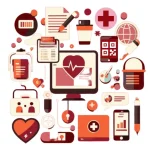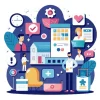
How to Collect Real-Time Patient Feedback Efficiently
In today’s healthcare landscape, collecting real-time patient feedback is crucial for improving patient care and enhancing the overall experience. Real-time feedback provides immediate insights into patient satisfaction, enabling healthcare providers to address concerns promptly and effectively.
This guide will explore how to collect real-time patient feedback efficiently using various systems and methods, ensuring you can make data-driven decisions that positively impact patient care.
Importance of Real-Time Patient Feedback
Real-time feedback is essential for several reasons:
- Immediate Action: Allows for quick responses to patient concerns.
- Improved Patient Experience: Helps in identifying and addressing issues promptly.
- Enhanced Quality of Care: Provides actionable insights to refine care processes.
Methods for Collecting Real-Time Patient Feedback
There are various methods to collect real-time patient feedback efficiently. Each method has its own set of advantages and can be used depending on your healthcare setting and resources.
1. Digital Surveys
Digital surveys are a popular method for gathering real-time feedback. These surveys can be distributed via email, text message, or through a mobile app like Lazymonkey, which simplifies the process for both administrators and participants.
- Advantages: Easy to deploy and analyze. Can reach a large number of patients quickly.
- Tips: Keep surveys short and focused. Use clear, concise questions to get actionable insights. Many real-time feedback systems, such as Lazymonkey, utilize digital surveys to streamline the process.
2. In-Person Feedback Kiosks
In-person feedback kiosks placed in waiting areas or near exits provide patients with a simple way to give feedback immediately after their visit.
- Advantages: Provides immediate feedback and is user-friendly.
- Tips: Ensure kiosks are easy to use and accessible to all patients. In-person kiosks are often part of a broader patient feedback system used by hospitals and clinics.
3. Mobile Apps
Mobile apps specifically designed for patient feedback can offer a seamless way for patients to share their experiences in real-time.
- Advantages: Convenient for patients and integrates well with other healthcare management systems.
- Tips: Ensure the app is user-friendly and offers a quick feedback process. Real-time feedback software often includes mobile app options for ease of access.
4. Text Message Surveys
Text message surveys allow patients to provide feedback via SMS, making it a convenient option for those who prefer mobile communication.
- Advantages: High response rates and instant feedback collection.
- Tips: Keep messages brief and provide easy-to-follow instructions. This method is effective in collecting patient feedback for doctors and hospital services.
5. Interactive Voice Response (IVR) Systems
Interactive Voice Response (IVR) systems use automated phone surveys to collect feedback from patients after their visit.
- Advantages: Suitable for patients who prefer voice communication.
- Tips: Keep the survey short and ensure the system is easy to navigate. IVR systems can be part of a comprehensive patient feedback system for hospitals.
Best Practices for Collecting Real-Time Patient Feedback
To ensure the effectiveness of your real-time patient feedback system, consider the following best practices:
1. Ensure Privacy and Confidentiality
Patients should feel confident that their feedback is confidential. Assure them that their responses are anonymous and used solely for improving care. Implement secure systems to protect their information, especially in real-time feedback software.
2. Make Feedback Easy and Accessible
Provide multiple options for patients to give feedback, catering to their preferences. Ensure the process is simple and quick to encourage participation. This approach is crucial for gathering patient feedback for nurses, doctors, and hospital services.
3. Act on the Feedback Promptly
Real-time feedback is only valuable if acted upon. Use the insights to make immediate improvements in patient care and communicate these changes to patients. This timely response is essential in maintaining high levels of satisfaction.
4. Train Staff on Handling Feedback
Ensure that staff members are trained to handle feedback effectively. They should understand how to address concerns and implement changes based on patient input. This training is vital for utilizing patient feedback for doctors and hospital services effectively.
5. Regularly Review Feedback Trends
Regularly analyze feedback trends to identify recurring issues or areas for improvement. This will help you make informed decisions and enhance patient satisfaction over time.
Case Studies: Successful Real-Time Feedback Implementation
Case Study 1: Hospital X
Hospital X implemented a real-time feedback system using digital surveys and in-person kiosks. They saw a significant increase in patient satisfaction scores due to their ability to address concerns immediately.
For instance, a common issue was long wait times, which the hospital was able to address by optimizing scheduling processes.
Case Study 2: Clinic Y
Clinic Y used a mobile app for real-time patient feedback, which allowed patients to rate their experience and provide comments instantly. The clinic used this feedback to improve appointment scheduling and streamline check-in procedures, leading to enhanced patient satisfaction and reduced waiting times.
Conclusion
Collecting real-time patient feedback efficiently is essential for improving healthcare services and patient experiences. By using various methods such as digital surveys, in-person kiosks, mobile apps, text message surveys, and IVR systems.
you can gain valuable insights and make timely improvements. Implement best practices to ensure the feedback process is smooth and actionable. Remember, the goal is to enhance patient care and satisfaction by responding to their needs promptly and effectively.
Frequently Asked Questions
What is Real-Time Patient Feedback?
Real-time patient feedback refers to immediate input from patients regarding their healthcare experience, collected while they are still receiving care or shortly after their visit.
Why is Collecting Real-Time Patient Feedback Important?
It allows healthcare providers to address patient concerns promptly, improve patient care, and enhance overall satisfaction.
What Are Some Methods For Collecting Real-Time Patient Feedback?
Methods include digital surveys, in-person feedback kiosks, mobile apps, text message surveys, and interactive voice response (IVR) systems.
How Can I Ensure Patient Privacy When Collecting Feedback?
Assure patients that their feedback is confidential and used solely for improving care. Implement secure systems to protect their information.
Enhance Patient Care and NABH Compliance with LazyMonkey
LazyMonkey is your all-in-one solution for improving patient care, retaining more patients, and meeting NABH standards. Our powerful QR-based feedback tool enables you to capture real-time insights from patient feedback, discharge surveys, staff and doctor evaluations, and clinical research, while also streamlining inter-departmental communication.
Transform your healthcare facility today - reach out to us at hello@lazymonkey.in, or request a demo here!
Elevate Your Restaurant Experience with LazyMonkey
LazyMonkey’s QR-based feedback system helps you gather real-time insights from customers, track satisfaction levels, and enhance the dining experience. Get instant feedback on your menu, service, and ambience, and make data-driven improvements to boost repeat customers and reviews.
Improve your restaurant today – reach out to us at hello@lazymonkey.in, or request a demo here!
Empower Student Engagement and Campus Improvement with LazyMonkey
LazyMonkey offers a seamless way to gather student feedback, track satisfaction, and enhance campus life. From course evaluations to dorm feedback, our QR-based solution makes it easy to capture valuable insights and improve student retention.
Upgrade your university experience – contact us at hello@lazymonkey.in, or request a demo here!
Streamline Feedback and Drive Performance Across Your Enterprise/Franchise with LazyMonkey
Whether you manage one or multiple locations, LazyMonkey’s QR-based feedback system helps you gather real-time employee and customer feedback. Improve operational efficiency, track satisfaction, and make data-driven decisions to enhance brand consistency and growth.
Transform your franchise today – reach out to us at hello@lazymonkey.in, or request a demo here!
Enhance Customer Satisfaction and Service Standards in Banking with LazyMonkey
LazyMonkey empowers banks to capture real-time feedback from clients across branches. Improve customer experience, assess service quality, and ensure regulatory compliance with our QR-based solution, helping you retain clients and meet banking standards.
Elevate your bank’s customer care – contact us at hello@lazymonkey.in, or request a demo here!
Boost Customer Engagement and Mall Satisfaction with LazyMonkey
LazyMonkey’s QR-based feedback tool enables you to collect feedback from shoppers, track satisfaction, and enhance the mall experience. Gather insights on store services, cleanliness, and entertainment to create an unmatched customer journey.














